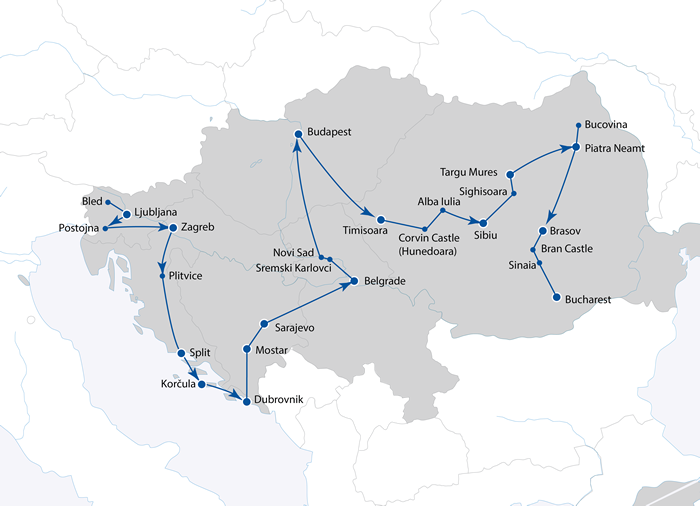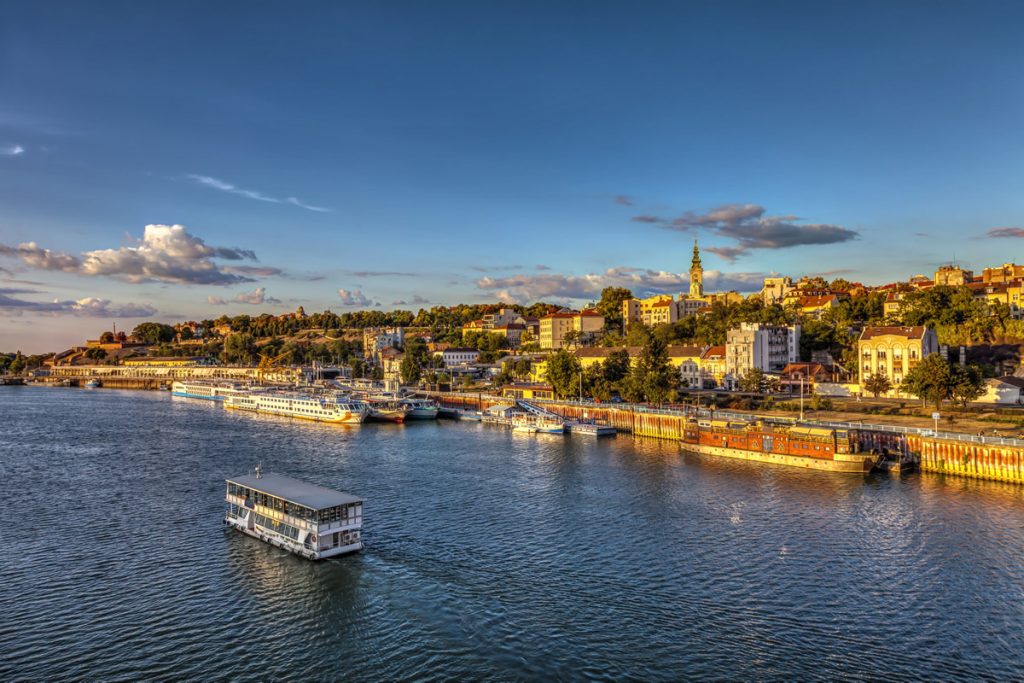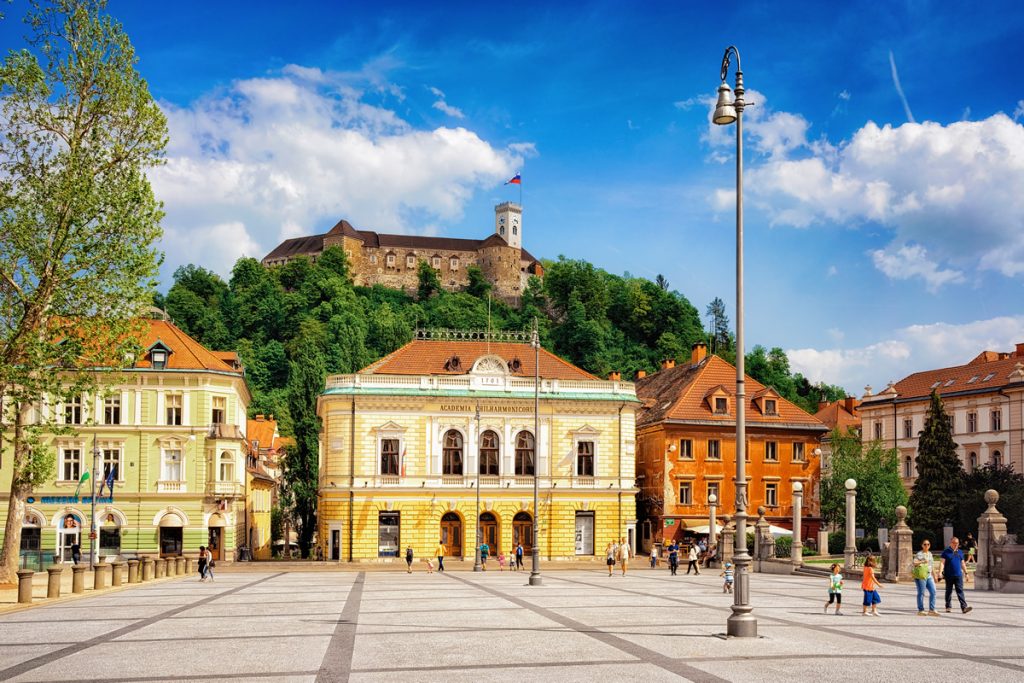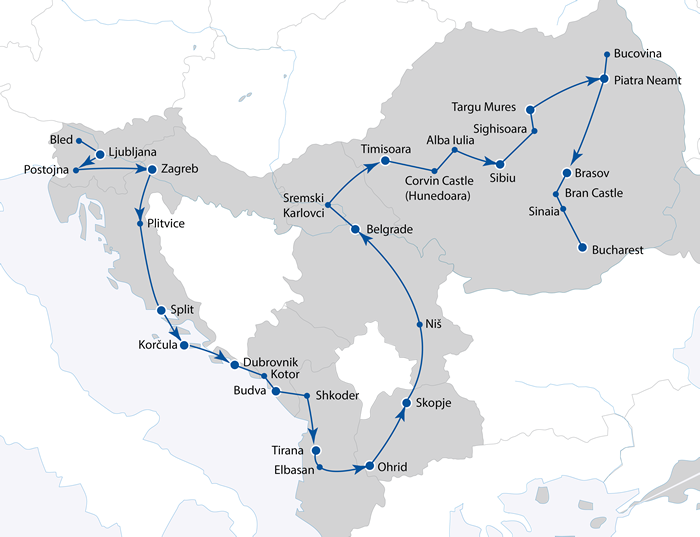An incredible 26 day fairytale journey through six amazing countries with the best highlights of the Balkans.
26 Days including Ljubljana, Bled, Postojna, Zagreb, Plitvice, Split, Korčula, Dubrovnik, Mostar, Sarajevo, Belgrade, Sremski Karlovci, Novi Sad, Budapest, Timisoara, Hunedoara, Alba Iulia, Sibiu, Sighisoara, Targu Mures, Bucovina painted monasteries, Brasov, Bran, Sinaia and Bucharest.

- Upon arrival to Venice, Trieste or Ljubljana airport transfer to hotel.
- This morning, we will first head to Bled, beautifully set in the Julian Alps. A sightseeing tour of Bled features the charming town, the lakeshore, and a visit to the imposing Bled Castle, perched on a cliff high above the lake.
- After the visit of Bled return to Ljubljana, the capital of Slovenia, for a walking tour. See the sights of the old city center, including the picturesque open-air Central Market, Three Bridges, Baroque Town Hall, and Robba’s Fountain.
- After breakfast, we head to Postojna, home to one of the largest caves in Europe – Postojna Cave. Tour this fantastic subterranean world by miniature electric train.
- Afterward, continue to Zagreb, the capital city of Croatia.
- This morning enjoy a city tour featuring the historic Upper Town, St Mark’s Church, St. Catherine’s Church, the Cathedral, Parliament, and the Government Palace.
- The rest of the day is free to explore the winding streets of the Old Town.
- Travel to spectacular Plitvice Lakes National Park. Have your camera ready as you take a walking tour around several of the lower lakes.
Enjoy the breathtaking scenery of this natural wonder of 16 terraced lakes surrounded by thickly wooded mountains and lush vegetation. - Then we continue our journey to Split.
- Enjoy a city tour featuring the historic inner city, built around the Roman Emperor Diocletian’s Palace, a UNESCO World Cultural Heritage site.
Finally, see the remnants of Split’s Roman heritage, its Renaissance and Gothic structures, Jupiter’s Temple, the Peristyle and the Cathedral.
- Today we head to the island of Korčula. Upon arrival free time to enjoy this beautiful island.
- The beautiful medieval town Korčula has streets arranged in the shape of a fish bone, which ensures the flow of fresh air and protects from strong winds. According to legend, the famous adventurer Marco Polo was born here.
- After the visit, head to Dubrovnik.
- Start the day with a walking tour of Old Dubrovnik this morning. Visit the Rector’s Palace, and see the Bell Tower Clock, Orlando’s Column and Sponza Palace.
- Next, see the Dominican Monastery and Franciscan Monastery with its Pharmacy, one of the oldest in the world.
- The rest of the day is at leisure to explore on your own, enjoy the picturesque setting, shop or simply relax.
- We continue our trip towards Mostar. Mostar is situated on the Neretva River and was named after the bridge keepers (mostari) who guarded the Stari Most (Old Bridge) over the Neretva in the medieval times. The Old Bridge, built by the Ottomans in the 16th century, is one of Bosnia and Herzegovina’s most recognizable landmarks, and is considered one of the most exemplary pieces of Islamic architecture in the Balkans.
- Travel to Sarajevo, the capital of the Republic of Bosnia and Herzegovina. The city of Sarajevo has been influenced by several cultures and civilizations over its long history. On your city tour, visit the Turkish Bazaar Bas Carsija, Husref Bay’s Mosque, the Olympic Stadium, and Gavrilo Princip Museum.
- Today, we travel to Belgrade, Serbia.
- With a history dating back more than 7,000 years, Belgrade is a fascinating city to visit. Your morning sightseeing tour includes the city’s main attractions: the imposing Kalemegdan Fortress, dramatically situated at the joining of the Sava and Danube Rivers; Republic Square and Mihajlova Street; Saint Sava Temple, the largest Orthodox Church in the city; and Tito’s Memorial. The afternoon is free.
- In the morning, departure to Sremski Karlovci, the museum-city that was the center of culture and religion in Serbia during the 18th and 19th centuries.
- After a short stop with a wine degustation included, we continue to Novi Sad, the capital of Vojvodina. It is the administrative, economic, cultural and university center of the region, which also has the well-preserved Petrovaradin Fortress that faces the city from the other side of the Danube.
- Return to Belgrade.
- Today we travel to Hungary and the capital city of Budapest. Upon arrival free time at leisure.
- In 1873, the twin cities of Buda and Pest joined with ancient Obuda to form a new, unified city, Budapest. Charming and beautiful, the city was declared a World Heritage site in 1987. Your morning sightseeing tour includes views of all the main attractions: The Parliament, Royal Palace, and the Castle Hill area, Fisherman’s Bastion, Matthias Church, Heroes’ Square, and Gellert Hill with its Citadel.
- The rest of the day is at leisure to explore this exciting city on your own.
- In the morning departure to Timisoara. Romania’s third-largest city (after Bucharest and Cluj-Napoca) is also one of the country’s most attractive urban areas, built around a series of beautifully restored public squares, and lavish parks and gardens. With western Romania’s nicest hotels and finest restaurants, it makes a perfect base for exploring the Banat region.
- In the morning, we travel to Hunedoara, where iron has been extracted since the Iron Age. One of its most memorable buildings is the Corvin Castle, a fine example of secular Gothic architecture with spiky, spooky fantasy topped with asymmetrical pointed towers and turrets.
- Continue to the city of Alba Iulia, a symbol of national unity in Romania. Built on 13th century foundations, the imposing Habsburg citadel is star-shaped with seven bastions and successive walls.
- Head to Sibiu for overnight.
- Morning free at leisure. In the afternoon we take a panoramic walk through the city of Sibiu. Sibiu is one of the most important cultural centers of Romania and bears a strong resemblance to a southern German or Austrian town. The old city center has retained a largely Saxon aspect and managed to fuse the Middle Ages with the new.
- Today, we travel first to the picturesque city of Sighisoara, the birthplace of Vlad Dracula. It is the only inhabited fortified citadel in Romania and is an enchanting city of sloping roofs, pastel facades and cobbled streets.
- We continue to Targu Mures.
- Targu Mures remains a noticeably Hungarian town. Dating back at least to the 14th century it has long been an important commercial and academic center.
- After the visit that includes the Palace of Culture, we continue to Piatra Neamt through the Bicaz Gorge, the largest gorge in Romania, admiring the beauty of the landscape, the Red Lake and its hill station.
- Departure to the Bucovina region to visit its monasteries, the most representative monuments of Moldovan art. Declared a World Heritage Site, these monasteries are one of the most important legacies of Byzantine art in the world, in which their brightly colored interior and exterior fresco paintings stand out.
- Visit of the Monasteries of Sucevita and the black pottery workshops of Marginea.
- In the afternoon visit the Voronet Monastery, considered the best architectural and pictorial example in the region, called the “Sistine Chapel” in the East.
- Return to Piatra Neamt.
- In the morning, we leave Piatra Neamt and travel south to Brasov. Arrival in the afternoon, followed by a tour of the fascinating medieval city of Brasov. Visit the old town and see the exterior of the Black Church, the most representative Gothic monument in Romania.
- Continuation towards the town of Bran. Visit of its famous Castle, also known as Dracula’s Castle.
- In the afternoon arrival in the city of Sinaia, known as “the pearl of the Carpathians” because of its beauty.
- In the afternoon we will visit the wonderful Peles Palace, the former summer residence and retreat place of the royal family, built in the second half of the 19th century by the first King of Romania, Carlos I.
- We will get to know the Romanian capital, once known under the nickname “Little Paris”. The visit will take us to the Romanian Athenaeum, the Opera House, the Military Club of the Nation, the Military Academy and the Arc de Triomphe. Bucharest is Romania’s capital and largest city, as well as the most important industrial and commercial center of the country. With 2 million inhabitants in the city proper and more than 2.4 million in the urban area, Bucharest is one of the largest cities in Southeastern Europe.
- After breakfast, you will be transferred to the airport for your departure flight.
Send a request / Contact us
GDPR Consent*
All details provided by you will be held by Kompas d.o.o and used in accordance with our Privacy Notice. By clicking ‘SEND’ you consent to Kompas d.o.o companies contacting you regarding the requested offer and information about our products and services.


